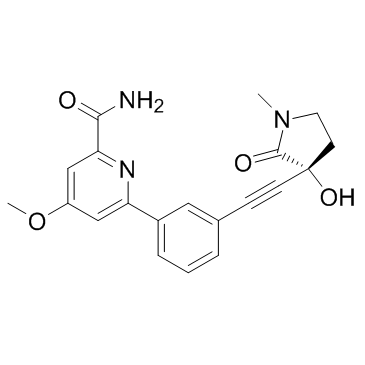| Description |
NIK SMI1 is a potent, selective NF-κB inducing kinase (NIK) inhibitor, which inhibits NIK-catalyzed hydrolysis of ATP to ADP with IC50 of 0.23±0.17 nM.
|
| Related Catalog |
|
| Target |
NIK[1]
|
| In Vitro |
NIK SMI1 (Compound 4f) inhibits NIK-catalyzed hydrolysis of ATP to ADP (fluorescence polarization, FP) with an IC50 of 0.23±0.17 nM. NIK SMI1 inhibits the expression of NIK SMI1 response elementregulated firefly luciferase reporter gene in HEK293 cells with an IC50 of 34±6 nM. Consistent with expectations for a NIK inhibitor, NIK SMI1 is shown to inhibit nuclear translocation of p52 (RelB) (IC50=70 nM). NIK SMI1 inhibits BAFF-induced B cell (mouse) survival in vitro with an IC50 of 373±64 nM[1].
|
| In Vivo |
C57BL/6 mice are treated twice daily for 7 days with orally administered NIK SMI1 or with three injections of recombinant BAFF receptor fusion protein (Br3- mIgG2a) over the course of the 7-day experiment as a positive control. The nonlinearity of exposure relative to dose between 100 and 200 mg/kg is a result of saturation of clearance mechanisms. The pharmacology of NIK SMI1 is examined in SD rat, CD-1 mouse, beagle, and cynomologous monkey with 20, 32, 18, and 7.8 mL/kg per min, respectively. Volume of distribution (Vd, L/kg) is 1.35, 1.58, 0.778, and 1.39, respectively[1].
|
| Cell Assay |
Human B cells are re-suspended in RPMI with 10% FBS for the proliferation assays and 2.5% FBS for the survival assays. Mouse B cells are plated in Co-star 96-well plates at either 50,000 cells/well for the survival assays or at 150,000 cells/well for the proliferation assays. Compounds (e.g., NIK SMI1) diluted in DMSO (final DMSO assay concentration=0.1%) are added to the cells. The cells are incubated with NIK SMI1 (10-9 nM, 10-7 nM, 10-5 nM, 10-3 nM, 0.1 nM, and 10 nM) for one hour at 37°C. Stimulus is then added to the plates and survival or proliferation is measured after four days. For the proliferation assays, cells are treated with either Anti-IgM (20 µg/mL) or rhCD40L (10 µg/mL) or anti-mouse CD40 (100 ng/mL). For the BAFF survival assay, cells are treated with human or mouse rBAFF at 10 ng/mL followed by Cell Titer Glo to measure survival on day four[1].
|
| Animal Admin |
Mice[1] Age-matched C57BL/6 mice are used. Only female mice are used in these experiments. The single oral doses of NIK SMI1 are 10, 20, 60, 100, and 200 mg/kg. For PO dosing, animals are manually restrained, then dosed via oral gavage using an appropriately sized gavage needle. Animals are monitored for any signs of aspiration or distress-respiratory abnormalities, lethargy, pale extremities, etc. For sample collection, 3 mice per group are bled a total of 8 times via tail prick using a 27 G needle (lateral tail vein). 10 μL of blood is collected at each timepoint and deposited into a pre-filled costar cluster tube containing 40 μL of 1.7 mg/mL EDTA/water, the tube is capped, votexed for 5 seconds, then stored on dry ice. Samples are transferred to a -80°C freezer for storage[1].
|
| References |
[1]. Blaquiere N, et al. Scaffold-Hopping Approach To Discover Potent, Selective, and Efficacious Inhibitors of NF-κB Inducing Kinase. J Med Chem. 2018 Aug 9;61(15):6801-6813.
|
